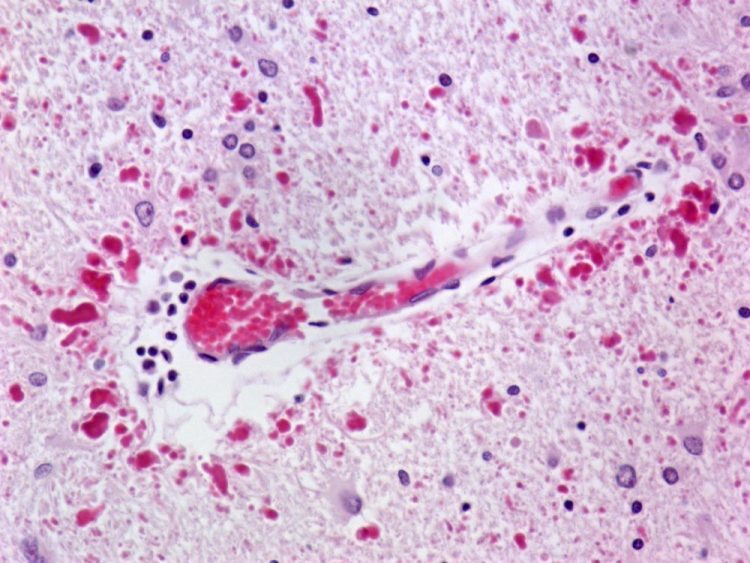Tracing a path toward neuronal cell death

Standard histology H&E staining of tissue from an eight-year-old Alexander disease patient. Rosenthal fibers -- the hallmark of the disease -- are shown in pink; nuclei are shown in blue. Image courtesy of Liqun Wang, Feany lab
Damage to astrocytes – star-shaped cells found in the brain and spinal cord – is found in many neurodegenerative conditions, but it's been unclear exactly what role astrocyte dysfunction plays in the development of disease.
Researchers at Brigham and Women's Hospital (BWH) have developed a genetic model that is yielding new insights into what happens when astrocytes go awry.
The research team developed a fruit fly model of Alexander disease, a neurodegenerative disease that primarily affects astrocytes, and was able to narrow in on the molecular signals leading to neuronal cell death, identifying nitric oxide (NO) as a critical mediator.
The team verified their results in a mouse model and also found evidence of activation of the same pathway in samples from patients with Alexander disease.
“We're excited to be contributing to a growing area of study of how astrocytes contribute to neurodegeneration, and to have uncovered a role for NO as a neuronal cell death signaling molecule,” said corresponding author Mel B. Feany, MD, PhD, a senior pathologist in the BWH Department of Pathology.
“Our findings define a potential mechanism for neuronal cell death in Alexander disease and possibly other neurodegenerative diseases with astrocyte dysfunction.”
Media Contact
All latest news from the category: Life Sciences and Chemistry
Articles and reports from the Life Sciences and chemistry area deal with applied and basic research into modern biology, chemistry and human medicine.
Valuable information can be found on a range of life sciences fields including bacteriology, biochemistry, bionics, bioinformatics, biophysics, biotechnology, genetics, geobotany, human biology, marine biology, microbiology, molecular biology, cellular biology, zoology, bioinorganic chemistry, microchemistry and environmental chemistry.
Newest articles

Zap Energy achieves 37-million-degree temperatures in a compact device
New publication reports record electron temperatures for a small-scale, sheared-flow-stabilized Z-pinch fusion device. In the nine decades since humans first produced fusion reactions, only a few fusion technologies have demonstrated…

Innovative microscopy demystifies metabolism of Alzheimer’s
Researchers at UC San Diego have deployed state-of-the art imaging techniques to discover the metabolism driving Alzheimer’s disease; results suggest new treatment strategies. Alzheimer’s disease causes significant problems with memory,…

A cause of immunodeficiency identified
After stroke and heart attack: Every year, between 250,000 and 300,000 people in Germany suffer from a stroke or heart attack. These patients suffer immune disturbances and are very frequently…





















